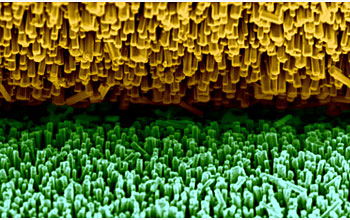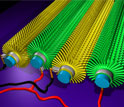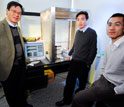|

Press Release 08-020
Remarkable New Clothing May Someday Power Your iPod®

The promise of piezoelectric fiber pairs
February 13, 2008
Nanotechnology researchers at the Georgia Institute of Technology are developing a shirt that harvests energy from the wearer's physical motion and converts it into electricity for powering small electronic devices worn by soldiers in the field, hikers and other users. The research, funded by the National Science Foundation (NSF) and described in the Feb. 14 issue of Nature, details how pairs of textile fibers covered with zinc oxide nanowires generate electricity in response to applied mechanical stress. Known as "the piezoelectric effect," the resulting current flow from many fiber pairs woven into a shirt or jacket could allow the wearer's body movement to power a range of portable electronic devices. The fibers could also be woven into curtains, tents or other structures to capture energy from wind motion, sound vibration or other mechanical energy. "The two fibers scrub together just like two bottle brushes with their bristles touching, and the piezoelectric-semiconductor process converts the mechanical motion into electrical energy," says Zhong Lin Wang, a Regents professor in the School of Materials Science and Engineering at the Georgia Institute of Technology. "Many of these devices could be put together to produce higher power output." Wang and collaborators Xudong Wang and Yong Qin have made more than 200 of the fiber nanogenerators. Each is tested on an apparatus that uses a spring and wheel to move one fiber against the other. The fibers are rubbed together for up to 30 minutes to test their durability and power production. The researchers have measured current of about four nanoamperes and output voltage of about four millivolts from a nanogenerator that included two fibers that were each one centimeter long. With a much improved design, Wang estimates that a square meter of fabric made from the special fibers could theoretically generate as much as 80 milliwatts of power. So far, there is only one wrinkle in the fabric, so to speak - washing it. Zinc oxide is sensitive to moisture, so in real shirts or jackets, the nanowires would have to be protected from the effects of the washing machine. The research was funded by NSF's Division of Materials Research. "This multi-disciplinary research grant enables materials scientists and engineers from varied backgrounds to work together towards translating basic and applied research into viable technologies," said NSF Program Manager Harsh Deep Chopra. The research was also sponsored by the U.S. Department of Energy and the Emory-Georgia Tech Nanotechnology Center for Personalized and Predictive Oncology.
-NSF-

Media Contacts
Diane Banegas, National Science Foundation (703) 292-4489 dbanegas@nsf.gov
John Toon, Georgia Institute of Technology (404) 894-6986 jtoon@gatech.edu
Program Contacts
Harsh D. Chopra, National Science Foundation (703) 292-4543 hchopra@nsf.gov
Principal Investigators
Zhong Lin Wang, Georgia Institute of Technology (404) 894-8008 zhong.wang@mse.gatech.edu
Related Websites
Professor Wang's Nano Research group: http://www.nanoscience.gatech.edu/zlwang/wang.html

The National Science Foundation (NSF) is an independent federal agency that
supports fundamental research and education across all fields of science and
engineering, with an annual budget of $6.06 billion. NSF funds reach all 50
states through grants to over 1,900 universities and institutions. Each year,
NSF receives about 45,000 competitive requests for funding, and makes over
11,500 new funding awards. NSF also awards over $400 million in
professional and service contracts yearly.
 Get News Updates by Email Get News Updates by Email
Useful NSF Web Sites:
NSF Home Page: http://www.nsf.gov
NSF News: http://www.nsf.gov/news/
For the News Media: http://www.nsf.gov/news/newsroom.jsp
Science and Engineering Statistics: http://www.nsf.gov/statistics/
Awards Searches: http://www.nsf.gov/awardsearch/
| 



